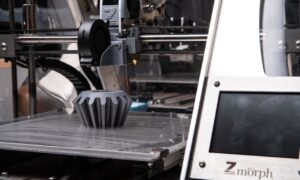Step into a world where the boundaries of imagination cease to exist and creativity takes on a whole new dimension. In this article, we embark on a thrilling journey into the realm of 3D printing technology, where innovation and artistry beautifully converge. Brace yourself to be captivated as we delve into the boundless potential of this groundbreaking technology, exploring its revolutionary impact on the worlds of art and design. From gravity-defying sculptures to exquisitely detailed jewelry born from digital dreams, join us as we explore the inspiring innovations brought forth by 3D printing technology. So, fasten your seatbelts and get ready to witness a fusion of imagination and technology like never before, because when it comes to unlocking creativity, nothing compares!
Understanding the technology
3D modeling is a revolutionary process for fabricating three-dimensional solid objects using a digital file as the blueprint. This creation is achieved through additive processes, where successive layers of material are meticulously deposited to form intricate shapes. 3D printing starkly contrasts traditional subtractive manufacturing methods, which involve removing material from a workpiece to create an object.
One of the most significant advantages is its ability to create complex shapes that are exceedingly challenging or impossible to achieve through conventional manufacturing methods. Furthermore, it enables the construction of objects with intricate internal structures, such as honeycombs or lattices.
Over the years, it has found extensive applications in fields such as medicine and dentistry, where it has been instrumental in producing implants and prosthetics. More recently, artists and designers have harnessed the power of 3D printing, leading to a surge of creative possibilities within these realms.
The Creative Benefits of 3D Printing Technology
Additive manufacturing, commonly known as 3D printing, provides a significant advantage for creativity, primarily through the rapid prototyping it enables. This is especially valuable for artists and designers who frequently iterate and experiment with their creations before finalizing a design. With this, artists and designers can swiftly explore multiple ideas without the laborious, time-consuming process of crafting each iteration manually.
Another substantial advantage for creative minds is the expanded range of materials and colors. While traditional prototyping by hand limits creators to available materials, 3D printing opens doors to a vast spectrum of possibilities. This diverse palette of materials fuels experimentation, inspiring new creative avenues.
Furthermore, the technology provides the means to produce highly customized products, making it an ideal tool for artists seeking to craft one-of-a-kind pieces that cannot be precisely replicated by anyone else.
Creative Applications
The advent of 3D printing technology has reshaped the art and design landscape, allowing creators to realize previously unimaginable designs and objects. Here are some inspiring examples of how 3D printing is being harnessed to craft remarkable works of art and design:
- Custom Jewelry: Companies like Shape ways have leveraged 3D printing to enable individuals to design and sell their unique jewelry creations.
- Sculptural Wonders: Artists like Joshua Harker have created intricate 3D-printed sculptures inspired by the beauty of nature.
- Tailored Furniture: Designers like Janne Kyttanen have introduced lines of 3D-printed furniture that can be tailored to fit any space perfectly.
- Life-Size Statues: Firms like Voxeljet employ 3D printing to produce life-size statues of both people and animals, redefining the possibilities of sculpture.
Getting Started
For those new to 3D printing, the initial steps might seem intimidating, but with guidance, you can quickly become proficient. Here’s a beginner’s guide to kick-start your journey:
- Select the Right 3D Printer: Extensive research is essential to identify a printer that aligns with your specific requirements and budget.
- Find Suitable Software: After acquiring a 3D printer, you’ll need software to design or download 3D models. Numerous software options are available, so choose one that suits your needs.
- Understanding the Printing Process: Familiarize yourself with the fundamentals of 3D printing before commencing any projects. This knowledge will prevent unexpected issues during printing.
With these fundamental steps in mind, you’ll be well-equipped to embark on your explorations in the world of 3D printing.
Tips and Strategies for Crafting Innovative Projects with 3D Printing
For those seeking guidance on crafting innovative projects using 3D printing, you’ve come to the right place. In this section, we’ll explore techniques to leverage 3D printing for creating unique and exceptional art and design pieces.
3D printing offers creators the exceptional ability to shape complex forms and structures, often unattainable through traditional manufacturing methods. Embrace this freedom and let your creativity flow when conceptualizing your projects.
Experimentation with various materials is strongly encouraged. 3D printers can work with an array of materials, from plastics to metals and even food. By testing different materials, you can discover the perfect medium for your specific project.
Thinking beyond conventional design boundaries is crucial. Just because something has been done before doesn’t mean it can’t be improved or reimagined. With 3D printing, you have the liberty to push limits and achieve something truly unique and groundbreaking.
Feel free to embark on your creative journey with these tips in mind. With 3D printing technology at your disposal, the possibilities are virtually limitless.
Alternatives to 3D Printing for Creative Endeavors
While 3D printing is a remarkable tool for creative projects, it’s essential to be aware of alternative methods for bringing your artistic ideas to life. Here are some viable alternatives to 3D printing for three-dimensional art and design:
- Sculpting: Traditional sculpting techniques using clay, stone, wood, or other materials remain a powerful means of creating three-dimensional art.
- Molding and Casting: When mass production is the goal, molding, and casting allow for the replication of an object multiple times. It involves creating a mold and then casting the desired object using various materials.
- CNC Milling: Computer Numerical Control (CNC) milling enables the precise machining of 3D objects from materials such as wood, plastic, and metal.
- Laser Cutting: Laser cutting, a computer-controlled method, can produce intricate 3D designs from sheet materials like paper, cardboard, wood, and acrylic.
- 3D Modeling: For ultimate control over your project, 3D modeling is an excellent choice. This method allows you to create virtual 3D models before deciding on physical fabrication methods.
Conclusion
3D printing technology serves as a powerful catalyst for unlocking creativity. It has ushered in a wave of innovation in the realms of art and design, offering artists and designers the ability to experiment, iterate, and create truly unique objects. As technology continues to evolve, the possibilities are limitless, promising to reshape the creative landscape in ways we can only imagine.
Whether you’re an established artist or an aspiring designer, 3D printing is an invaluable tool to push the boundaries of creativity. Embrace this transformative technology, experiment fearlessly, and let your artistic vision soar to new heights. With 3D printing, the fusion of imagination and technology is limited only by your creativity.



































